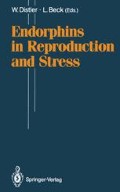Abstract
Hormones of the hypothalamus-pituitary adrenal (HPA) axis are released into the blood as part of the organism’s response to stressful stimuli. These hormones do not only act on peripheral tissues but feed back to the central nervous system, thus forming part of an afferent humoral system modulating a great variety of brain functions, including functions not directly related to the endocrine regulation such as sensory processing and sleep (Fig. 1). In rats, the systemic administration of the proopiomelanocortin (POMC) peptides ACTH 4–10 and β-endorphin has been shown to delay extinction of conditioned avoidance behavior and to affect the hippocampal θ rhythm (de Wied and Jolles 1982; de Wied et al. 1978; Urban and de Wied 1976). Receptors located at the blood— brain barrier and in the circumventricular organs are possible mediators of the central effects of these hormones after peripheral administration (see, e.g., Meisenberg and Simmons 1983; van Houten and Posner 1983).
This work was supported by a grant from the Deutsche Forschungsgemeinschaft (to H.L.F.). The study was approved by the committee on Research Involving Human Subjects of the University of Ulm.
Access this chapter
Tax calculation will be finalised at checkout
Purchases are for personal use only
Preview
Unable to display preview. Download preview PDF.
References
Born J (1989) Untersuchungen zur afferenten humoralen Beeinflussung zentralnervöser Aktivität beim Menschen. Habilitationsschrift, University of Ulm
Born J, Bathelt B, Pietrowsky R, Pauschinger P, Fehm HL (1990) Influences of peripheral adrenocorticotropin 1–39 (ACTH) and human corticotropin releasing hormone (h-CRH) on human auditory evoked potentials (AEP). Psychopharmacology (Berlin) 101: 34–38
Born J, Bothor R, Pietrowsky R, Fehm-Wolfsdorf G, Pauschinger P, Fehm HL (1987a) Influences of vasopressin and oxytocin on human event-related brain potentials in an attention task. J Psychophysiol 4:351–360
Born J, Bräuninger W, Fehm-Wolfsdorf G, Voigt KH, Pauschinger P, Fehm HL (1987b) Dose-dependent influences on electrophysiological signs of attention in humans after neuropeptide ACTH 4–10. Exp Brain Res 67:85–92
Born J, Kern W, Pietrowsky R, Sittig W, Fehm HL (1989a) Fragments of ACTH affect electrophysiological signs of controlled stimulus processing in humans. Psychopharmacology (Berlin) 99: 439–444
Born J, Späth-Schwalbe E, Pietrowsky R, Porzsolt F, Fehm HL (1989b) Neurophysiological effects of recombinant interferon gamma and alpha in man. Clin Physiol Biochem 7:119–127
De Wied D, Bohus B, van Ree JM, Urban I (1978) Behavioral and electrophysiological effects of peptides related to lipotropin (β-LPH). J Pharmacol Exp Ther 204:570–580
De Wied D, Jolles J (1982) Neuropeptides derived from proopiocortin: behavioral, physiological, and neurochemical effects. Physiol Rev 62:976–1059
Hillyard SA, Hink RF, Schwent VL, Picton TW (1973) Electrical signs of selective attention in the human brain. Science 182:177–180
Jacquet YF (1979) Dual mechanisms mediating opiate effects? Science 205:425–426
Meisenberg G, Simmons WH (1983) Peptides and the blood—brain barrier. Life Sci 32:2611–2623
Näätänen R, Gaillard AWK, Mantysalo S (1980) Brain potentials of voluntary and involuntary attention. In: Kornhuber HH, Deecke L (ed) Motivation, motor and sensory processes of the brain: electrical potentials, behaviour and clinical use. Elsevier, Amsterdam, pp 343–348
Van Houten M, Posner BI (1983) Circumventricular organs: receptors and mediators of direct peptide hormone action on brain. Adv Metab Disord 10:269–289
Urban I, de Wied D (1976) Changes in excitability of the theta activity generating substrate by ACTH 4–10 in the rat. Exp Brain Res 24:325–344
Editor information
Editors and Affiliations
Rights and permissions
Copyright information
© 1990 Springer-Verlag Berlin Heidelberg
About this paper
Cite this paper
Born, J., Fehm, H.L. (1990). Effects of Blood-Borne Endorphin and Other POMC-Derived Peptides on Brain Functions in Man. In: Distler, W., Beck, L. (eds) Endorphins in Reproduction and Stress. Springer, Berlin, Heidelberg. https://doi.org/10.1007/978-3-642-75797-6_14
Download citation
DOI: https://doi.org/10.1007/978-3-642-75797-6_14
Publisher Name: Springer, Berlin, Heidelberg
Print ISBN: 978-3-540-52736-7
Online ISBN: 978-3-642-75797-6
eBook Packages: Springer Book Archive

